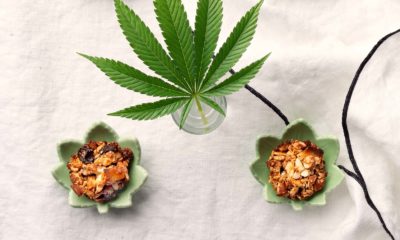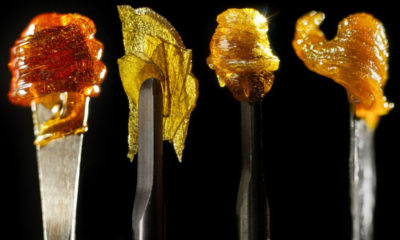
Cannabis
Lyme Disease: The Forgotten Illness
Lyme disease may not be the first thing that comes to mind when considering the use of medicinal cannabis, but that may change soon as cases of this debilitating, tick-born disease multiply across the U.S.
After long suspecting being infected by a tick at the age of seven, Colorado native Rachel Nordman was eventually diagnosed with Lyme disease when she was a teenager. By the time the illness was identified, she was already suffering from the severe effects of late-stage Lyme disease – extreme joint pain, inflammation, vomiting, hives and fatigue. After conventional treatments failed to offer relief, Nordman turned to a simpler, more effective therapy.
“Cannabis has helped me in many different ways,” says Nordman, 22. “Fatigue is one of the hardest symptoms I deal with. From the moment I wake up, I feel exhausted and ready to go back to sleep. Sativa strains help me combat this fatigue and get more done.”
Researchers at the Cary Institute of Ecosystem Studies in Millbrook, N.Y. recently reported that changing weather patterns have led to an early tick season and the troubling expansion of the parasites’ range into new geographic areas. Ticks are not only being found in traditionally rural areas but also in urban environments like city parks and playgrounds. Although the Northeast of the U.S. has historically had the highest rate of infection, Lyme has been recorded in most parts of the country as well. The Center for Disease Control and Prevention (CDC) reports that approximately 30,000 cases of Lyme disease are brought to their attention yearly in the U.S.
“I treat a lot of Lyme in my practice and more and more I’m starting to recognize that there are patients that I’ve been treating for years for chronic pain, insomnia, anxiety, that I’m now recognizing as Lyme, ” says Dr. Dustin Sulak of Maine, a concentrated area for Lyme. “I’ve [seen] people with Lyme responding well to cannabis.”
He recommends the use of cannabinoids for therapy against the disease.
“There are days my skin or joints feel like they’re on fire,” says Nordman. “On high pain days, edibles and cannabis-based salves help relax my muscles and combat inflammation in my joints. High CBD strains or CBD tinctures give me fast relief from this pain. After trying many different nonsteroidal anti-inflammatory drugs, I have yet to find something that works as well as cannabis.”
While professionals have found that those who receive antibiotic treatment in the early stages of Lyme disease can make a swift and full recovery, the CDC reports that 10-20 percent of sufferers can develop a condition called “Post-treatment Lyme disease,” wherein symptoms such as chronic pain and fatigue may linger. For those who don’t seek treatment in time, late-stage Lyme disease is often a debilitating condition that has the capacity to drastically alter a person’s life. Symptoms include neurological issues including chronic pain (which often manifests as joint and muscle aches), stiffness, extreme fatigue, insomnia, loss of facial muscle tone, headaches, inflammation and arthritis. Additionally, there are many mental and emotional ailments associated with the disease, such as anxiety, depression, brain fog and memory loss.
“What [the Lyme diagnosis] meant for me at the time was that my life, as I had shaped it to be, was over,” says Lucy, who resides in a cannabis prohibition state. She conveys how she was diagnosed with Lyme in 2007 and underwent the standard antibiotic treatment — yet she continued to suffer with chronic pain and other life-altering symptoms.
“For years I had been a voracious athlete, with the stress of my world demolished through a run, weight lifting session or intensive yoga or Pilates workout,” says Lucy. “My entire world and identity shifted so dramatically. I went from being able to lift amounts more than twice my size to barely being able to walk without severe pain. At times, it became so bad that I would trip or fall and hurt myself or drop things. And I always worried about fainting or blacking out. Cognitively, the Lyme makes it so that sometimes my mind goes completely blank and I am unable to form sentences.”
Thankfully, patients have found relief with cannabis treatment.
“One of the things that I think is most important for dealing with Lyme is the ability to rest,” says Dr. Sulak. “There’s this over activity, inflammation and toxicity in the nervous system. It prevents rest and stillness and that makes it really hard to deal with stress. Cannabis is excellent for bringing people to a point of stillness, especially if it’s used in conjunction with other therapy.”
Sulak says he begins his therapy with a low-dose approach. The method of consumption varies widely from patient to patient based on their individual needs. He also believes that in addition to traditionally heated cannabinoids, raw cannabinoids have significant healing potential for Lyme patients.
“I’m 100 percent convinced that raw cannabinoids have anti-seizure properties. I’ve seen it first-hand. So I know they are having a stabilizing and protecting effect on the nervous system, which is the organ that people often suffer with the most with Lyme infection.”
Neuropathy, cognitive changes and insomnia — Lyme attacks numerous parts of the body.
“It does enjoy being in connective tissues and the nervous system,” says Sulak. “That’s where it shows up the most. And so having anything that’s going to be protective to the nervous system is a strategy for treating Lyme. Cannabinoids, both raw and heated, are excellent neuroprotectors.”
While there is scarce peer-reviewed research specifically on the topic of treating Lyme with cannabis, physicians like Sulak are witnessing positive effects in patients first hand.
“Blue Dream is one of my favorite strains for overall pain, severe achiness and relaxation,” says Lucy. “Throughout the daytime, I use either a tincture or cannabis infused coconut oil. I also utilize a topical cream infused with cannabis from a company called Apothecanna. It mostly aids in reducing inflammation and is easily applied to joints or muscles that swell or hurt when I am doing physical tasks at work or home. Nothing that I have ever come across has fundamentally shifted my battle with Lyme into a positive yet challenging experience in the way cannabis has.”
Though Lyme has no known cure, cannabis treatment is steadily evolving as a powerful medicine for managing the symptoms of the disease and restoring a sense of normalcy to people’s lives.
“I don’t feel trapped inside a malfunctioning body when I medicate with cannabis,” says Lucy. “Living productively while medicated has enabled me to further delve into the relationship I have with my most inner self. Healing chronic illness requires dramatically slowing down one’s life in order to restore mind, body and spirit. I have hope again with cannabis. It enables me to visualize a completely pain-free life in the future. I can dream, create, feel love and give love, work, socialize and connect with others. I can move freely. This is the herb that makes my life with Lyme worth living.”
By Rae Lland
Originally published in Issue 16 of Cannabis Now. LEARN MORE
TELL US, do you use cannabis for healing?

























